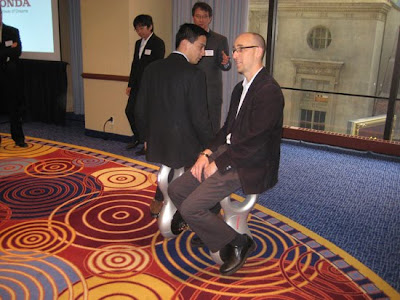

 Honda's remarkable U3-X personal mobility prototype is the device Segway inventor Dean Kamen should have introduced. Shaped like a figure 8, Honda's omni-directional, robotics-controlled U3-X is like an intelligent unicycle, where your own balancing skills are not required.
Honda's remarkable U3-X personal mobility prototype is the device Segway inventor Dean Kamen should have introduced. Shaped like a figure 8, Honda's omni-directional, robotics-controlled U3-X is like an intelligent unicycle, where your own balancing skills are not required.Unveiled last year at the Tokyo Motor Show, the U3-X has never been ridden in the U.S.—until now. I got a rare chance to try out the prototype at an invite-only event in Manhattan. Honda execs started the afternoon with a brief overview of the U3-X. The device, at roughly 25 inches high and six inches wide, is small enough to fit between your legs. Two small foot rests flip out from either side, and the top half of the device opens, butterfly-style, to provide a cushioned leather seat. The U3-X weight about 22 lbs and has a handle on top for easy carrying. However, since the U3-X balances itself (a trick learned from Honda's ASIMO robot), you can simply hold the handle and roll it along. Its lithium-ion battery holds an hour charge and features a rather unique omni-directional wheel system (called an Omni Traction Drive System) that can roll forward on the full-size wheel or sideways on dozens of little wheels that sit inside the larger wheel. Balancing is provided by accelerometers and sensors that detect the rider's center of gravity and make constant adjustments to keep the U3-X and rider in perfect balance. Riding is simply a matter of leaning, slightly, in the direction you want to go.
After the talk, we got a brief primer on exactly how to ride the U3-X: While facing away from the device, hold the seat with two hands and back onto the U3-X. At the same time, put one foot on one footrest. Sit down and then pick up the other foot. This worked for me exactly as described and within seconds I was gliding across the floor. Subtle movements of my upper back and shoulders sent to forward, back and side-to-side. To make, say, a hard right or left turn, I'd put one foot on the floor and gently turn. I rarely had to do this, though, because the U3-X responded to even my most subtle movements. The U3-X can travel up to three MPH, but even at this top speed, I never felt like I had to make a sudden movement to stop or avoid a collision. I just leaned back a bit in the opposite direction and the U3-X stopped. At one point, I rode in unison with another U3-X rider. I never feared falling and noticed that bumping into the other rider didn't send the U3-X or me into a tail spin.
I've ridden a Segway and, while it's an amazing device, it was never this simple or—more importantly—unobtrusive. A product like this that allow personal mobility to the able and, potentially, disabled, without needing special pathways, or sticking out like a store thumb, is something else altogether.
Honda wouldn't share the software platform or actual CPU intelligence inside the U3-X. That's not surprising for a prototype device. More distressing, though, is that the product, which took years develop has no "to-market" plan—or at least not one Honda would share. Honda execs would only say that it's still a prototype and they don't know when consumers will get their hands—or butts—on it.
Source;
http://www.pcmag.com/article2/0,2817,2362334,00.asp